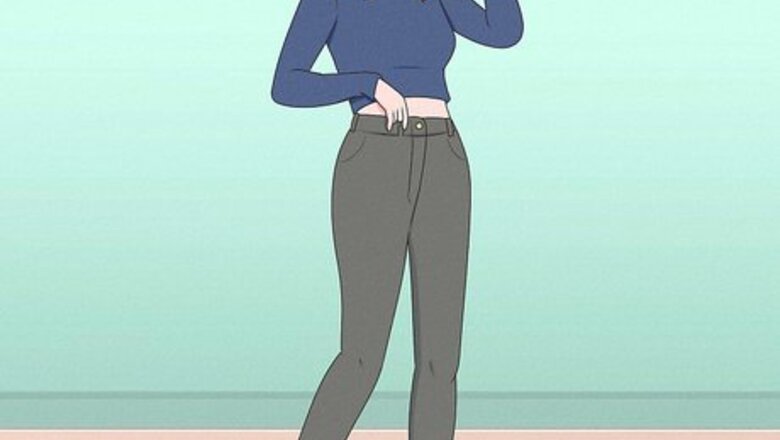
views
Choosing the Right Clothes
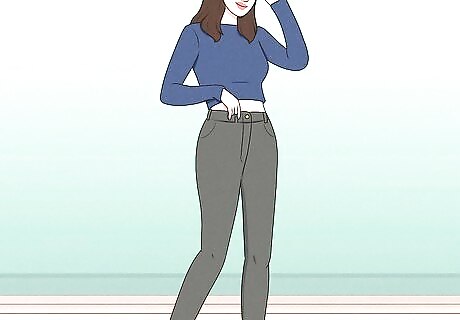
Wear clothes that fit. Fitted pants and tops that seem custom made for your body will make you look long and lean. If you’re petite, shop in the petite section of stores to boost your chances of finding clothes that fit properly. Baggy and ill-fitting clothes will only make you look frumpy, and will do nothing to lengthen your legs. Avoid buying clothes that don’t fit you perfectly. If this is unavoidable, either have your clothes tailored or tailor them yourself so that they fit well. Make sure that your pants are hemmed correctly, so that they just graze the top of your foot. Don’t let them bunch up and wrinkle at the top of your foot or shoe, as this will make your legs look shorter.
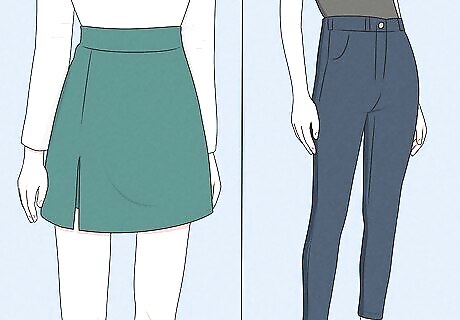
Wear high-waisted skirts and pants. Aim for skirts and pants that go just above your natural waist. These will make your legs look longer by giving the impression that your legs start where your waist does. Low-rise bottoms will generally lengthen your torso and make your legs look shorter, so avoid these.
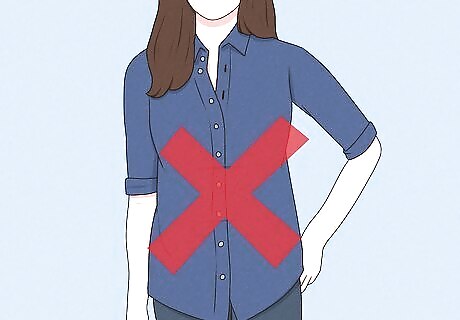
Avoid long, untucked tops. Wearing long tops will make your torso look longer and your legs look shorter. Tucking a top into high-waisted pants will give the illusion of longer legs.

Wear cropped jackets and tops. Tops, sweaters, and jackets that end anywhere from your waist to just above your hips will shorten your body and lengthen your legs, especially when paired with high-waisted bottoms.
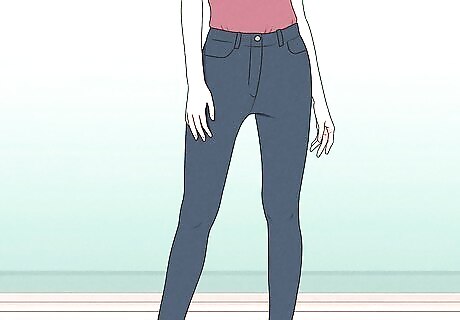
Wear skinny jeans. A lot of experts recommend wearing skinny jeans or narrow straight-legged pants, particularly in dark shades, to give your legs a longer appearance. This is particularly effective when the pants are worn with heels in the same shade — for example, black jeans with black pointy-toed ankle boots.

Wear wide-legged pants with heels. Make sure the hemline grazes the floor at the back, and the top of your foot at the front, while you’re wearing heels. If the pants are too long for you, your legs will look shorter, so get them tailored or hem them yourself if need be. Wide-legged pants have much the same effect as skirts and dresses, as they can help hide exactly where your legs start. Aim for high-waisted, wide-legged pants for maximum leg-lengthening effects! Pair a wide-legged pant with a wedge for a comfortable, retro look.
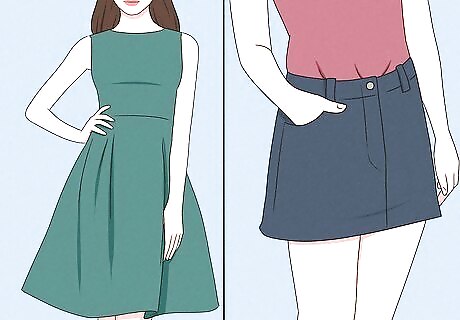
Wear dresses and skirts. Dresses and skirts conceal where your legs start, which can help give the illusion of longer legs. A-line and pencil skirts are good choices. Higher waistlines help with the leg-lengthening illusion. Short skirts with high waistlines are great for making your legs look longer.
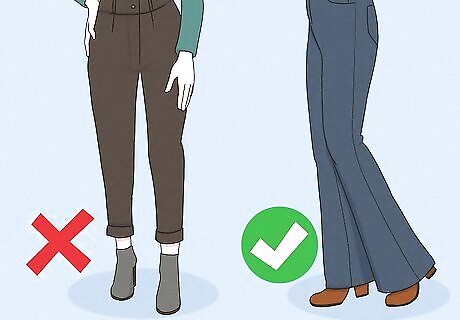
Check your hemlines. In particular, avoid skirts, dresses, and pants whose hemlines fall around the calves, as this is generally the thickest part of the leg. A hemline that ends at your calf will likely make your legs look thicker and shorter. In addition, be careful about wearing hemlines that cut straight across your legs, as these can interrupt the line of your legs and make them look shorter. Asymmetrical hemlines make the transition from fabric to leg more smooth and clean, giving the illusion of longer legs.
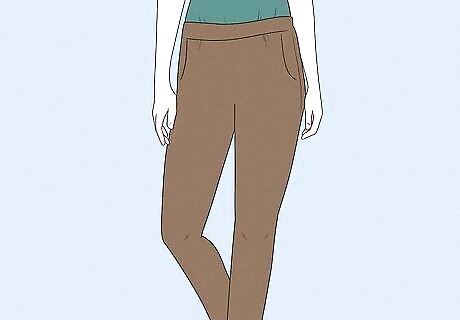
Aim for a clean silhouette. The cleaner the lines, the more long and lean you will look in general. In particular, avoid bottoms that have embellishments on them, as these could make you look more bulky, and your legs look shorter. Bottoms to avoid include pants, skirts, and dresses with cuffs, pleats, or big pockets. Also avoid bottoms with low back pockets, which can make your bum look lower and your legs look shorter. Jeans with horizontal tears and distressing on them may also cut up the line of your legs and make them look shorter.
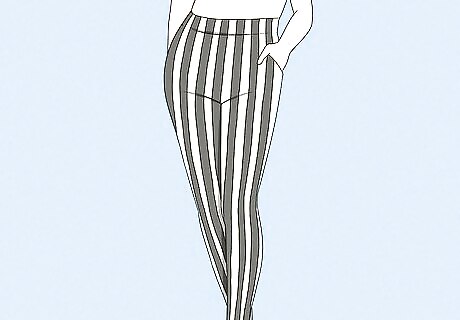
Seek vertical details on bottoms. Wearing bottoms with vertical piping, creases, or lines on them will help make your legs look longer by drawing the eye up and down the length of them. Pants with vertical stripes on them will work well. Stripes create a stylish optical illusion as long as the fit isn't too tight and the stripes can hang straight up and down.
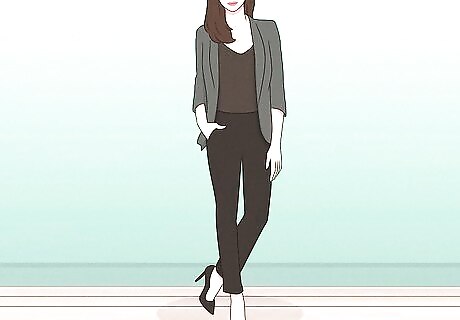
Wear a monochromatic outfit. Wearing one color from head to toe will help you — and your legs — look long and lean. Stick to darker shades for the best results. A popular color to wear is all black.
Choosing the Right Footwear
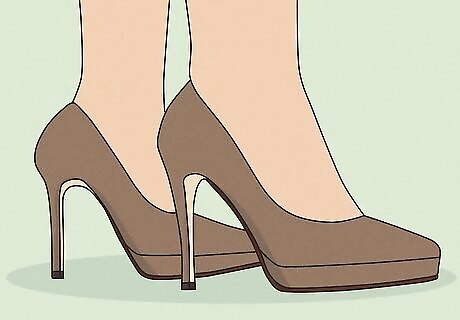
Wear high heels. High heels are a quick way to give your legs an instant length-boost. Even low heels will help, so don’t feel obligated to immediately jump into the highest heels you can find. Aim for the highest heels you can wear while still being comfortable. Having longer-looking legs will do nothing to boost your confidence or make you look sexier if you can’t walk in your heels!
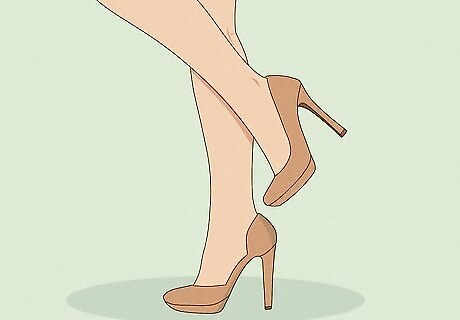
Wear shoes that match your legs. Whether you’re wearing a skirt, a dress, or pants, opt for a shoe that matches whatever color your legs are. Doing this will make your legs look longer by creating an uninterrupted line down your legs to your feet. If you’re wearing nude nylons or bare legs, wear a shoe that matches the natural (nude) color of your legs. If you’re wearing blue jeans, go with a bare/nude-colored foot and a nude heel. If you’re wearing black skinny jeans or black tights, wear black high heels or ankle boots.

Get creative with color. You needn’t wear the exact same color of shoe as your legs to achieve longer-looking legs. You can achieve the same effect by wearing shoes in a similar shade to the rest of your outfit. This is particularly true for dark colors. For example, you could wear a pair of dark brown or navy ankle boots (don’t forget the pointy toe!) with black skinny jeans. If you’re doing this, however, be sure that your shoes still go with the rest of your outfit!
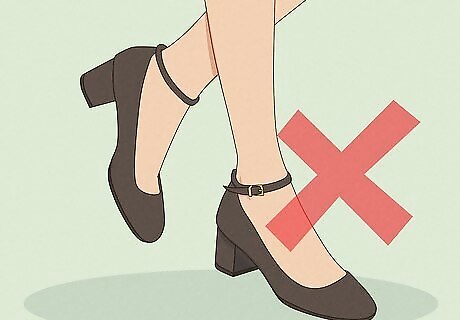
Avoid shoes with ankle straps. The straps will interrupt the long line of your legs, and can make them look shorter. If you do wear ankle straps, go with short shorts or a miniskirt to increase the length of uninterrupted leg. You can also wear ankle-strap-shoes with skinny jeans as long as the straps are high up on your ankle and thus right at the hemline of the jeans, so that there is no gap between the jeans and the strap.
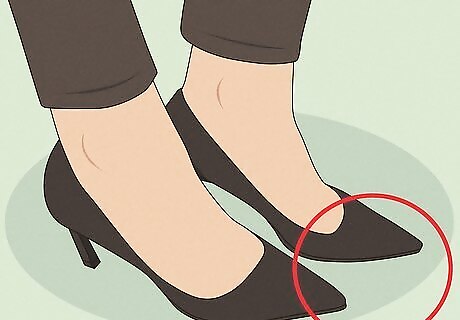
Wear pointy-toed shoes. Round- and square-toed shoes can make your legs look shorter. Pointy-toed shoes help flatter and lengthen short legs. The more foot that is exposed (i.e. the lower the vamp), the better. Pointy-toed shoes make your legs look longer by making your feet look longer, so pay attention to the length of the point to ensure that it still looks good with your feet. You don’t want to look like you have clown feet!
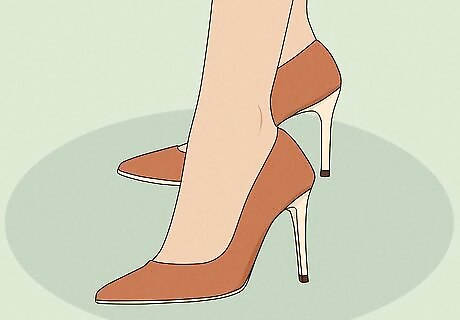
Wear shoes that have a low vamp. The vamp is the part of the shoe that covers the top of your foot from your ankle to your toes. Shoes with a low vamp, that covers only the toes (and maybe even shows some toe cleavage), will make your legs look longer. Avoid flats and heels with high vamps, as these can break the line of your leg and make it look shorter. The exception to this is ankle boots in the same color as your pants/tights. Just make sure that there is no skin- or other-colored gap between your pants/tights and your shoes.
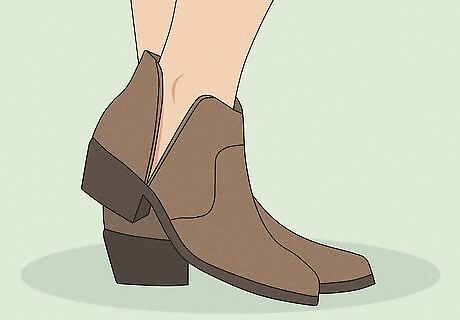
Wear boots with a v-shaped cut-out at the ankle. If you’re wearing boots, consider the same principles as the horizontal hemline for skirts and dresses: an asymmetrical or v-shaped line will create a smoother transition between your skin at the fabric, making your legs look longer.

Try tall boots. Some stylists recommend against calf-hugging boots, but lower or higher ones can work well to lengthen legs. Aim for a boot that fits your leg snuggly, and wear it in the same color as your bottoms. If you’re wearing a skirt or dress, aim for a hemline that extends past the top of the boot so that there is no gap between your hemline and boot, which would interrupt the line of your body.
Exercising for Long, Lean Legs
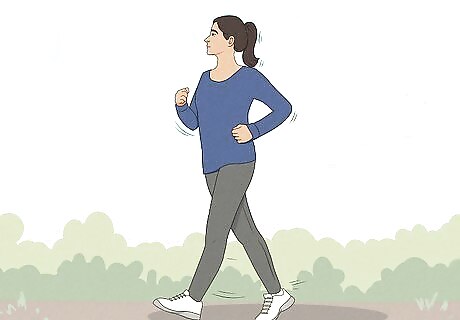
Know how much exercise you need. Experts recommend that healthy adults get at least 150 minutes of moderate aerobic activity or 75 minutes of vigorous aerobic activity each week. In addition, you should do strength-training exercises at least twice a week. Examples of moderate aerobic exercise include brisk walking, swimming, or household chores such as mowing the lawn. Vigorous activities include running or dancing (e.g. Zumba). Examples of strength-training exercises include lifting weights or using weight machines, or rock climbing. Note that you can combine moderate and vigorous activities as well, for example by going for a walk with intervals of running.

Aim for at least 30 minutes a day of physical activity. If you are looking to lose weight, you may need to do more than this. Some experts recommend aiming for 300 minutes of exercise a week. Dancers are famous for their long, lean, and toned legs. To get legs like a dancer, consider incorporating some dance classes into your weekly exercise routine.
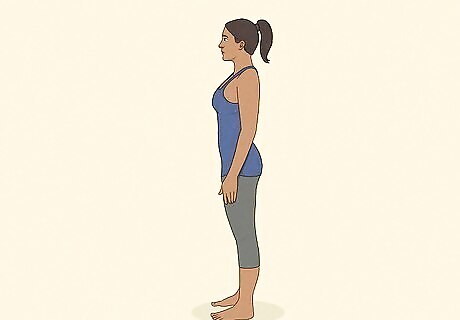
Maintain a good posture. In all of the exercises you do, be sure to maintain a good posture. If you’re standing, your shoulders should be back and down (not hunched), your abs should be firm (tummy pulled in), and your chin should be parallel with the floor. If you’re on your hands and knees, your hands should be stacked below your shoulders, and your knees should be below your hips. When you look down, the creases between your hands and wrists should be horizontal and parallel with the front of your exercise mat. In addition, your stomach should be strong (pulled in), your shoulders should be pulled down and away from your ears, and your neck should be long, with your chin slightly tucked.

Do lateral leg lifts. This exercise helps with posture, core strength, and balance, and strengthens your inner and outer thighs, calves, and ankles. You can wear ankle weights to add an extra boost to this exercise: Stand with your feet together and your hands on your hips. Your knees should have a gentle bend to them — make sure they’re not locked. Soften your left knee slightly and tighten your abs as you lift your right leg sideways as high as it will go, then glide your leg back down the same way you lifted it, until your foot is just above the ground. Pulse your right leg back up twice before returning to stand with both feet beside each other. Transfer your weight to your right leg and repeat the two-pulse leg lift with your left leg. Continue to alternate legs until you’ve completed 20 reps on each side.

Do bow and arrow lunges. This exercise builds balance and core strength, lengthens your quadriceps, and strengthens your buns and thighs: Stand with your feet hip width apart and your arms extended out in front of you at shoulder height. Take a big step forward with your left leg and then bend both of your knees to 90-degree angles to lower into a forward lunge. Be sure that your knees are directly over your ankles and not extended past them. Your knees should not be hanging over your toes. Use your left heel (front leg) to push back up into a standing position, then rotate your body and toes so that you come to a wide-legged squat. At the same time, pull your right arm back across your chest, as if you’re pull the string back on a bow and arrow. Push through both of your heels to return to your left-leg lunge with your arms straight out in front of you. Repeat 20 times on one side, then switch to the other side.
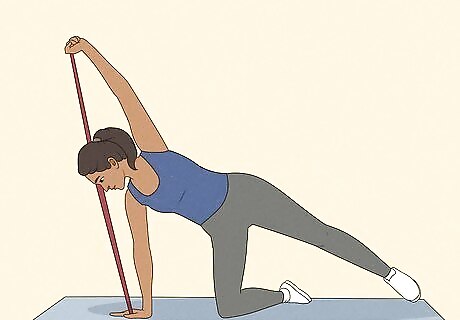
Do kneeling knee dips. This will strengthen your glutes, hamstrings, and inner and outer thighs. Be sure to keep your abs tight, your shoulders down (away from your ears), and your neck long (chin slightly tucked) as you do this exercise: Get down on to your hands and knees, with your knees beneath your hips and your wrists beneath your shoulders. To protect your wrists, make sure that your wrist creases are in line with your exercise mat (i.e. horizontal). Use a mat to protect your knees. Pull your left leg backwards to cross your left knee and foot over your right calf. Maintaining that angle, push your left knee out to the side — it should go slightly back and up — and then lower it back to its position over your right calf, being sure not to let it touch your calf or the ground. Do 20 reps on before switching to your right side.

Explore other leg exercises. Included in this article are just a few leg-lengthening exercises. Other exercises that will help make your legs look lean and long include pliés, leg lifts, squats and lunges, and leg rolls.
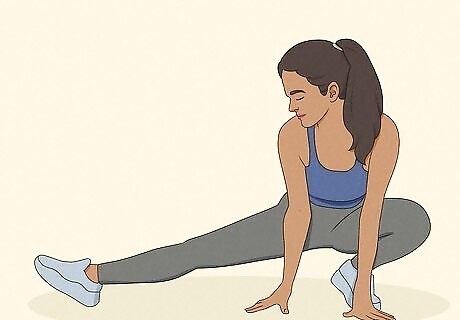
Don’t forget to warm up and cool down. Warming up and cooling down before and after exercise, respectively, will improve the quality of your exercise and help prevent soreness and injury. The idea with warming up is to lightly work the muscles you intend to use in your main workout. Aim to do at least a few minutes of light cardio (e.g. walking) before weight-training or going for a run, for example. Give yourself at least 10 to 15 minutes to do some light cardio and stretching after a workout session. As an example, after a run you might walk for a few minutes and then transition to a stretching session.



















Comments
0 comment